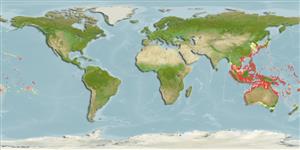Environment: milieu / climate zone / depth range / distribution range
Ecologia
marinhas associadas(os) a recifes; intervalo de profundidade 2 - 55 m (Ref. 30874). Tropical; 22°C - 28°C; 43°N - 40°S, 95°E - 130°W (Ref. 55292)
Pacific Ocean: Cocos-Keeling Islands and Western Australia (Ref. 27362) in the eastern Indian Ocean to the Marquesas and Oeno (Pitcairn group), north to southern Japan and southern Korea, south to Lord Howe Island, northern New Zealand, and the Austral Islands. Replaced by the very similar Pterois miles from the Red Sea to Sumatra.
Length at first maturity / Tamanho / Peso / Idade
Maturity: Lm ?, range 16 - ? cm
Max length : 45.7 cm TL macho/indeterminado; (Ref. 118189); peso máx. Publicado: 1.4 kg (Ref. 118189); Idade máx. registada: 10 anos (Ref. 72479)
Espinhos dorsais (total): 13; Raios dorsais moles (total): 9-12; Espinhos anais 3; Raios anais moles: 6 - 8. Scales cycloid (Ref. 37816). Variable in color, usually in relation to habitat. Coastal species generally darker, sometimes almost black in estuaries. Often with large tentacles above eyes (Ref. 48635).
Inhabit lagoon and seaward reefs from turbid inshore areas to depths of 50 m. Often solitary, they hide in unexposed places at daytime often with head down and practically immobile. Pelagic juveniles expatriate over great distances and the reason for their broad geographical range (Ref. 48635). Hunt small fishes, shrimps, and crabs at night, using its widespread pectorals trapping prey into a corner, stunning it and then swallowing it in one sweep. Dorsal spines are venomous; the sting can be treated by heating the afflicted part and application of corticoids (Ref. 5503). A popular table fish.
Life cycle and mating behavior
Maturidade | Reprodução | Desova | Ovos | Fecundidade | Larvas
Myers, R.F., 1991. Micronesian reef fishes. Second Ed. Coral Graphics, Barrigada, Guam. 298 p. (Ref. 1602)
Categoria na Lista Vermelha da IUCN (Ref. 130435)
Utilização humana
Pescarias: espécies comerciais; Aquário: Espécies comerciais
Mais informação
ReferênciasAquaculturaPerfil para aquaculturaEstirpesGenéticaElectrophoresesHereditariedadeDoençasProcessamentoNutrientsMass conversion
Ferramentas
Relatórios especiais
Descarregue XML
Fontes da internet
Estimates based on models
Preferred temperature (Ref.
123201): 22.4 - 29, mean 27.9 °C (based on 756 cells).
Phylogenetic diversity index (Ref.
82804): PD
50 = 0.5005 [Uniqueness, from 0.5 = low to 2.0 = high].
Bayesian length-weight: a=0.00813 (0.00632 - 0.01046), b=3.08 (3.01 - 3.15), in cm total length, based on LWR estimates for this species (Ref.
93245).
Nível Trófico (Ref.
69278): 4.4 ±0.4 se; based on diet studies.
Resiliência (Ref.
120179): Elevada, tempo mínimo de duplicação da população menor que 15 meses (Preliminary K or Fecundity.).
Fishing Vulnerability (Ref.
59153): Low to moderate vulnerability (34 of 100).
Nutrients (Ref.
124155): Calcium = 49.1 [27.1, 97.8] mg/100g; Iron = 0.68 [0.36, 1.80] mg/100g; Protein = 18.7 [16.7, 20.7] %; Omega3 = 0.219 [0.100, 0.610] g/100g; Selenium = 34.6 [19.2, 83.9] μg/100g; VitaminA = 109 [42, 285] μg/100g; Zinc = 0.857 [0.586, 1.244] mg/100g (wet weight);
